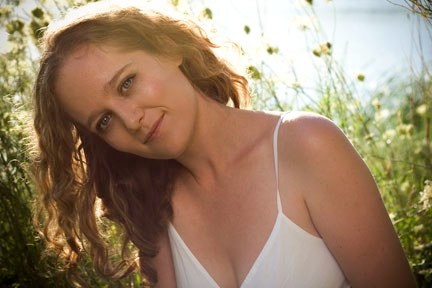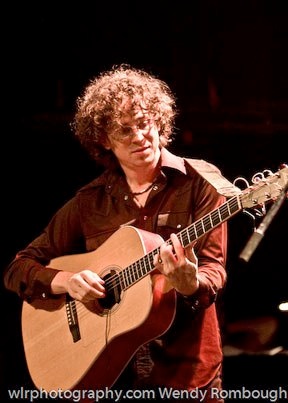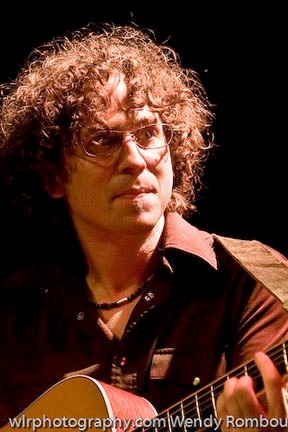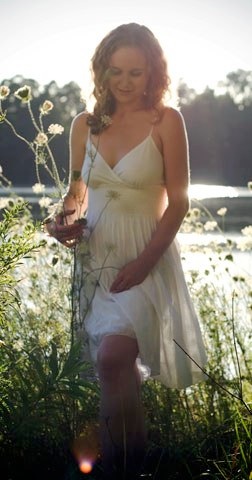Layah Jane
And Her Right Hand Man
by Richard Cuccaro
It started with John Platt, host of WFUV-FM’s Sunday Morning Breakfast show. During the 2009 Northeast Regional Folk Alliance Conference, he said, “You’ve got to head over to the DJs’ afternoon meeting. A singer from Toronto is going to do a showcase. Her name is Layah Jane. She’s phenomenal!
I headed over to the mezzanine several minutes late, and peeked in. No one was singing. This turned out to be a blessing. I walked out to the landing and, there she was, with her guitarist/accompanist partner, Oliver Johnson. Their style is what might be termed “jazzy folk.” I asked if she’d be singing for the DJs and she responded that it had already taken place. However, she’d be willing to sing again, somewhere else. A couple of other interested presenters showed up, as I suggested we go to my own guerrilla showcase room. Thus, about six of us got our very own private Layah Jane showcase performance — about 3 songs. All of us were flabbergasted. Exquisitely good looking, she sounds as good as she looks. In concert, sometimes she sings solo with just Oliver on guitar and on some songs, she and Oliver both play guitar. I wrote in the following month’s NERFA wrap-up issue: “She’s like Diana Krall with a guitar. Without it, perhaps even a bit more.” Later, listening to her voice on some recorded tracks, I thought, “What if Sadé decided to become a folk artist? Layah Jane would be the result.” On paper, that might not seem like much, but seen live, it packs quite a wallop. Additionally, it happens that Oliver is a brilliant, seasoned guitarist, having toured Canada with top-of-the-line acts. Although Layah’s songs are a throwback to the jazz/fusion of New York’s WRVR-FM in the late ‘70s- early ‘80s, Oliver’s cornucopia of acoustic guitar stylings are enough to satisfy any but the most die-hard folkie purist.
A video from that impromptu showcase session, taken by Dennis DaCosta, is posted on Youtube and can also be viewed on her website. After she sings “Saltwater Taffy,” just before the video cuts off, you can hear me say “Wow!”
So, “Wow” being the operative term, when the opportunity to feature her presented itself, we jumped at it.
Beginnings
Layah grew up in the east end of Toronto in an area called “The Beaches,” near Lake Ontario. Wikipedia states: “She and her sister were raised by a psychotherapist/singer-songwriter father and a poet mother.” Even as a toddler, she was unusually gifted. Layah told me: “We always had a piano in the house and my dad plays guitar as well. We have home videos of me prancing around in my diapers, singing along with the music that he loved. From the time I was really small, for as long as I can remember, there was music. It was a very important part of my upbringing. The transition to doing it professionally felt very natural for me. It wasn’t like one day it occurred to me, ‘Oh, I could do this.’ It just naturally grew, I think.
Referring to her father again, she said “He writes folk/roots music, but he exposed us [her younger sister is an actress] to all kinds of artists. He played Bruce Cockburn, Joni Mitchell, Dire Straits, The Pointer Sisters, Bruce Springsteen, The Beach Boys, Cyndi Lauper, Kate Bush … I never did any rebelling against my parents’ choice of music. I just took it and ran with it.”
Continuing, she added, “I was very involved with all kinds of performing in school. I was in choir all the way through elementary school. When I started taking piano lessons at home at 8 years old, I started studying show tunes, so I could sing along with what I was playing, and I got into musicals. Then I started taking guitar lessons in high school. I also did an independent songwriting class in my last years of high school. I had a really supportive music teacher. He allowed me to take one period a week and write songs, then present them at the end of the year in a show, and he graded me on that.”

“We had a coffeehouse in high school, and I was performing there. I think I was about 17 when I performed for the first time at a legendary Toronto coffeehouse called The Free Times Cafe. The booker of the cafe was there that night and he invited me to do my first full-blown gig a few months later.”
She seems to have displayed remarkable poise as a high school graduate. The question concerning what direction to take with her life still hung in the air and she appears to have approached it with a calm deliberation in incremental stages. She said: “Right after high school, I went traveling for a year and got a government grant to make my first demo recording during that year.”
This was the point at which Layah connected with long-time friend, Oliver Johnson, to handle the studio end of making the demo. Layah met Oliver when she was just 9 years old and Oliver was already 17. Their families were close friends and they’d have various holiday dinners, celebrating a variety of spiritual doctrines together as they saw fit.
When Layah needed to put together her first demo, Oliver was ready. “He was the only guy I knew with a studio,” she said.
Oliver & the Two-fold Path
Oliver’s early years were filled with motion. He grew up initially in Peterborough, NH. His father was a huge Woody Guthrie fan. His mother worked as a waitress at The Folkway, a prestigious folk club. Oliver got to see national touring acts such as Arlo Guthrie at a very young age. His parents split up when he was 4 and his mother moved to Boston. He shuttled back and forth between Boston and New Hampshire.
His father loved to sing and he played guitar and bass. Although music was primarily a hobby, he had an array of musical instruments in the living room, including a drum kit.

As Oliver recounts it, he was lucky to have gotten supportive parents in both his father and stepdad. It was actually his stepdad who got him his first guitar. Oliver has always had a fondness for the blues. Back then, he was into John Lee Hooker, Muddy Waters, Booker T. & the MGs, The Butterfield Blues Band, and he couldn’t get enough of Jimi Hendrix. After dinner he and his stepfather would sit and play a 12-bar blues for hours at a time.
When he was at his father’s house, they’d jam till the wee hours and sometimes the police would come. He’s still amazed at the way his father would cajole the officers, claiming the sound wasn’t all that bad.
“I was very fortunate to have two men in my life who loved me very much and who guided me in the direction that brought me such happiness, in music and otherwise,” he says.
Oliver’s early musical education consisted of mostly listening and playing with friends. He never really studied … until he went to Humber College in Toronto, which has a program similar to Berklee College of Music in Boston.
In order to learn musical theory, Oliver approached a guitarist, Wayne Cass, to show him what he needed to know to get into the Humber jazz program. Cass was “a great guitar player and a great teacher,” a favorite that Oliver would watch play in clubs. Oliver would pay for a 45-minute lesson and still be there, 3 hours later. They’d listen to and dissect music for the first 2 hours. In 3 months, Oliver learned everything he needed to know to get into Humber, entering at age 22. He learned a lot of theoretical things that allowed him to communicate ideas, rather than hashing them out by demonstrating on the guitar.

Toward the end of his first year at Humber, he damaged his hand while moving a heavy table. He couldn’t play guitar for 3 months and wasn’t able to play for his exams. During those 3 months, he got a job in a computer store that sold software for digital recording. He learned about the software and about producing and, as an employee, was able to purchase the software at an affordable price. When it came time to re-enroll in school, he was tapped to play for a group that toured all over Canada. He chose that and, between playing on the road and producing when he got home, he never went back to school. His education was as complete as he needed it to be.
At a certain point, the road started to wear Oliver down and he decided to focus on production. He found a partner and opened up a studio that, today, works predominately on television projects.
At this point, Layah approached Oliver to produce the demo for which she’d gotten a grant. Oliver hadn’t really been fully aware of her musical ability. “It wasn’t until she came to me with her songs that I realized what talent she had,” he told me.
A Balanced Life Plan

In the statement that follows, we can see the wheels turning as she weighed her options: “I came home knowing that I really wanted to pursue music and I made my first recording. After making that first demo, I decided to study homeopathy medicine and nutrition. During the first few years of pursuing music, I had some questions about how it would pan out and whether this really was a good spot for me. I also wanted to utilize other parts of myself. School always allowed me to do that.”
“I’ve always been interested in holistic health and alternative, complementary medicine I grew up in a very ‘alternative’ household. My parents were, and are, ‘hippies,’ immersed in the alternative scene. I personally experienced a lot of different kinds of modalities including homeopathy, acupuncture, massage and chiropractic and all the rest.”
Layah enrolled in and completed a three year program at The Toronto School of Homeopathic Medicine and received a DSHomMed, Homeopathic Certification.
While involved with her studies she was pursuing music as well, performing quite a bit with Oliver. “It was hectic,” she said, “I would plan tours for the summer and March break and weekend jaunts around Ontario and more local stuff. I was really busy, a lot of juggling. However, I never regretted studying homeopathy. I feel that it enriched my life. Even though I’m primarily pursuing music at this point, it enriched my life in such a great way, in terms of being able to help myself and my family and friends and broadening my understanding of the human body. Also, it’s important to know how to take care of yourself on the road.”
Not strictly a purist, she believes that a mixture of alternative and traditional Western medicine, “the best of both worlds,” according to each patient’s needs is the best solution.
A Certain Magic

During this time, Layah won numerous Canadian music awards. In addition, some readers might remember the Dove Self Esteem Fund’s 2006 “True Colors” TV Campaign. The voice singing “True Colors” was Layah Jane’s.
Through her early career, the Canadian government played a role. Each time Layah had any doubts about music as a chosen path, every time she needed it, a grant would come through. Layah would take this as a sign that she should continue to pursue music. “I just kept following those affirmations from the outside world. Connecting with audiences on tour helped a great deal, too.”
“In Canada, the opportunity exists for musicians to apply for grants. We feel very fortunate to have access to these grants, but the competition is ridiculously steep.” [It’s been a personal observation while reviewing CDs for the Acoustic Live December NERFA wrap-up issue, that the Canadians are so deep in talent, maybe one of these years we may have to give up the entire “NERFA CD Haul” review section to them. Not yet, though.]
For two or three years, Layah and Oliver remained friends while they played music together. Layah’s first two full CDs followed after they became a couple.
Things that Go Bump

A stylistic shift occurred, affecting the songwriting for that first record. Layah had to put the guitar aside and let Oliver provide the instrumental accompaniment solo. This actually broadened their range. The “lemonade-from-lemons” character of both accidents might lead one to believe that a certain magic guided them. “Magic plus tenacity” would probably describe it better.
Layah says that Oliver has influenced her, injecting some jazz, R & B, soul and funk, given that he had gone on tour with some of the better Canadian players in that realm. When I touched on this, Oliver demurred, saying that Layah had brought her own wide range of influences for him to have had all that much effect on her sense of style.
It’s easy to see why The Ontario Arts Council, and the Foundation to Assist Canadian Talent on Records (FACTOR) came through with grants at critical moments. Her soaring, pitch-perfect vocals and melodic sense are mesmerizing. Then, there’s the writing. In “Dry Wit” on Grievance & Gratitude , she sings::
How’d your humour get so dry?
I lick my lips, pull my collar high
It’s a clinging melancholy
underlying this pleasant jolly
How’d ya get so easy to fool?

Additionally, Acoustic Live will be hosting its own annual guerrilla showcase at the Northeast Regional Folk Alliance and we’ll get to watch Layah and Oliver play a set in our own room. They’ll also play a formal Tricentric showcase and numerous other showcases (see the performance list below).
The new CD, Honey, from Layah and Oliver is just about ready for release and we’ve gotten to hear a few sample songs. In one of the three downloads we got from Sonicbids, “Dandelion,” she sings:
Where we gonna go when the well is dry?
Pulling up buckets of empty sky
Taking our thirst on loan
Dry as a bone
Some prescient thoughts of hard times to come, perhaps. Layah will always have a keen ear for the vagaries of love and relationships, but she has her eye on the fate of humankind as well.
Thanks to John Platt, we’re getting to know Layah and Oliver quite well. We hope our readers do the same!
Website: layahjane.com
Upcoming Appearances include:
Nov 11-14 Northeast Regional Folk Alliance Conference, Kerhonkson, NY
Thursday:
Acousticmusicscene.com’s Midnight Hoot Showcase
Friday:
9:45pm Tricentric Showcase
11:45pm Concerts in Your Home Showcase
1am Acoustic Live Showcase
Saturday:
2:30pm Folk the War Showcase
12:15am Music at the Mission Showcase Lounge
1am Suite Maple Sugar Showcase
Nov 16 7:30pm The Bees Knees, Morrisville, VT
18 7:30pm Music on 4 NYC, NY
19 8pm Our Times Coffeehouse, Garden City, NY
20 8pm Burlap and Bean, Newton Square, PA
28 8:30pm Trane Studio, Toronto, ON


